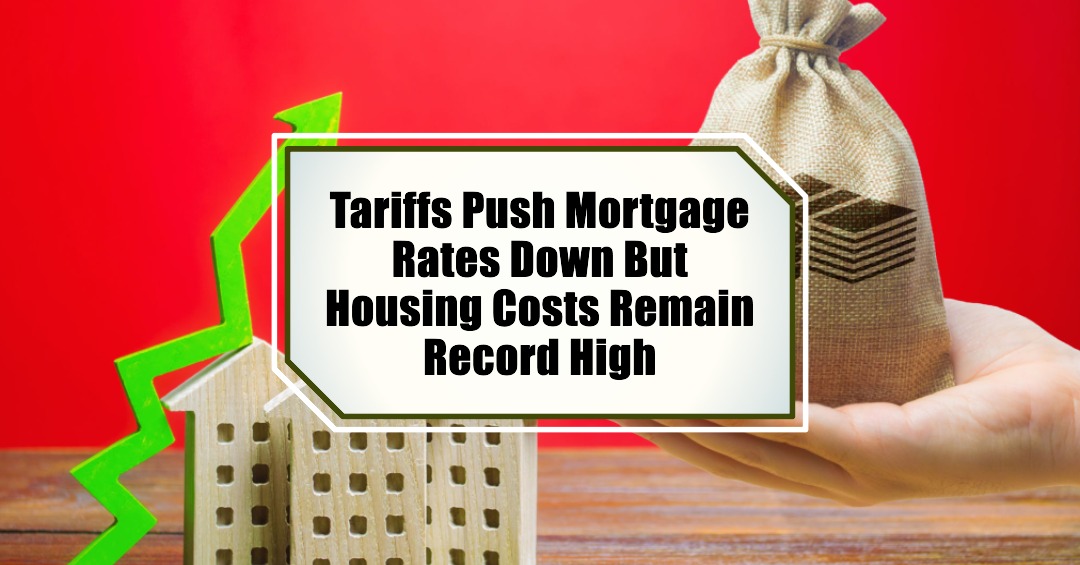Mortgage rates have indeed taken a dip, partly due to the ongoing trade tensions and tariffs, which is usually welcome news for anyone looking to buy a home or refinance. However, the reality is that even with these lower borrowing costs, the overall cost of buying a house remains stubbornly high, hovering near record levels.
It's a confusing situation, and if you're trying to navigate the world of real estate, you're probably wondering what this all means for you. Well, let's unpack this and try to make some sense of it together.
Tariffs Push Mortgage Rates Down But Housing Costs Remain Record High
The Good News: Lower Mortgage Rates
First, let's talk about the silver lining: those sinking mortgage rates. You might be asking, how exactly do tariffs play a role in this? It's a bit of a roundabout connection, but here's the gist. When there's uncertainty in the global economy, like what can happen with trade disputes and the imposition of tariffs, investors often look for safer places to put their money.
U.S. Treasury bonds are often seen as such a safe haven. When demand for these bonds increases, their yields (which are inversely related to their prices) tend to fall. Mortgage rates, particularly for 30-year fixed-rate mortgages, often follow the trend of these Treasury yields. So, as tariffs and trade concerns create economic uncertainty, pushing investors towards bonds, we often see a corresponding decrease in mortgage rates.
For potential homebuyers and those looking to refinance, this can be a real benefit. Lower rates mean lower monthly payments, making homeownership more accessible or freeing up cash for other expenses. I remember when I was first looking to buy, even a small change in the interest rate could have a significant impact on my budget over the life of the loan.
To put it simply:
- Economic uncertainty (partially due to tariffs) → Increased demand for U.S. Treasury bonds → Lower Treasury yields → Lower mortgage rates.
The recent announcement of tariffs by the Trump administration has actually sent ripples through the financial markets. When there's an expectation of potential disruption to global trade, investors often look for safer places to put their money, and that often means buying bonds. This increased demand for bonds pushes their yields down, and since mortgage rates loosely follow the yield on the 10-year U.S. Treasury, we've seen a corresponding decrease in borrowing costs.
Specifically, the average rate on the popular 30-year fixed loan plunged by a significant 12 basis points to 6.63% on a recent Thursday, according to Mortgage News Daily. This was the lowest level we've seen since October. It's a noticeable drop and could potentially save homebuyers a decent chunk of money on their monthly payments over the life of a loan.
The Tariff Effect: A Double-Edged Sword?
While lower mortgage rates sound great on the surface, the reason behind this drop – tariffs – is something we need to consider carefully. Tariffs can lead to higher prices for imported goods, potentially impacting the overall economy and even leading to inflation down the line. This uncertainty is what initially spooked the stock market, causing that “flight to safety” into bonds. It's a reminder that economic forces are interconnected, and what seems like good news in one area might have less desirable consequences elsewhere.
The Unyielding Challenge of High Housing Costs
Now, let's tackle the other side of the coin: why are housing costs still so stubbornly high despite these lower mortgage rates? Several factors are at play here, and they paint a more complex picture for prospective buyers.
- Persistently High Home Prices: Even with a slight cooling in some markets, overall sale prices are still up 3.4% year over year. This means that even with a lower interest rate, the base cost of the house itself remains a significant barrier.
- Record-High Monthly Payments: According to Redfin, for the four weeks ending March 30th, the typical U.S. homebuyer's monthly payment hit a record high for the second week in a row, reaching $2,802. This starkly illustrates how the combination of still-high prices and even moderately lower rates can still result in a hefty monthly burden.
- Affordability Crisis: The numbers are quite sobering. Estimates suggest that roughly 70% of households, or 94 million, cannot afford a $400,000 home. This is based on current income levels and lending standards. To put it in perspective, the estimated median price of a new home in 2025 is around $460,000, according to the National Association of Home Builders.
- Income vs. Home Price: Consider this: the minimum income required to purchase a $200,000 home at a mortgage rate of 6.5% is around $61,487. In 2025, it's estimated that over 52 million households in the U.S. have incomes at or below this threshold, meaning they can realistically only afford homes priced at $200,000 or less. The availability of homes in this lower price range is a major issue.
- Supply and Demand Mismatch: While it's true that we're seeing a growing supply of homes coming onto the market, the crucial point is that this supply isn't necessarily in the price range where demand is highest. There's still a shortage of more affordable homes, particularly at the lower end of the market. This is partly a legacy of chronic underbuilding since the Great Recession.
Recommended Read:
Mortgage Rates Likely to Go Down in the Short Term Due to Tariffs
Will Mortgage Rates Go Down in April 2025? Here's What the Experts Say
Expect High Mortgage Rates Until 2026: Fannie Mae's 2-Year Forecast
Will Mortgage Rates Rise Back Above 7% or Go Down in 2025?
Will New Tariffs Actually Lead to Lower Mortgage Rates in 2025?
What This Means for Homebuyers (My Perspective)
As someone who's been watching the housing market closely, this situation feels like a frustrating Catch-22.
Let's consider a simplified example (and remember, these are just illustrative concepts, not actual data):
Imagine a home priced at $400,000.
- If mortgage rates were at 5%, your monthly principal and interest payment might be around $2,147 (this doesn't include property taxes, insurance, etc.).
- Now, let's say mortgage rates drop to 4%. For that same $400,000 home, your monthly principal and interest payment would be closer to $1,910. That's a savings of $237 per month, which is definitely helpful!
However, what if those same market forces we discussed have also pushed the price of a comparable home up to $450,000? Even with the lower 4% interest rate, your monthly principal and interest payment would be around $2,149 – almost exactly what it was with the higher rate on the cheaper house!
You get a little relief with lower borrowing costs, but the fundamental issue of high home prices remains firmly in place. From my perspective, this highlights a few key takeaways for anyone looking to buy:
- Don't Expect Miracles: While the dip in mortgage rates is welcome, it's unlikely to drastically change the affordability landscape overnight, especially if home prices remain elevated.
- Be Realistic About Your Budget: It's more crucial than ever to have a clear understanding of what you can truly afford, factoring in not just the mortgage payment but also property taxes, insurance, and potential maintenance costs.
- Location Matters More Than Ever: In more affordable areas, the drop in rates might have a more significant impact on your purchasing power. However, in high-demand markets, the benefit might be less pronounced.
- Increased Inventory Offers More Choices (Potentially): The fact that new listings jumped by 10% annually in March, and active listings were up roughly 28% year over year is a positive sign. It means buyers might have more options to choose from, potentially leading to less intense bidding wars in some areas. However, as mentioned before, the price point of these new listings is key.
- Homes Are Sitting on the Market Longer: The data also shows that homes are staying on the market for a longer duration, and the share of listings with price reductions is rising. This suggests that the market might be starting to cool slightly in some areas, giving buyers a bit more leverage.
- Pending Sales Are Down: The fact that pending sales fell 5.2% in major metropolitan areas indicates that buyer demand might be softening in response to the high costs. This could eventually put downward pressure on prices, but it's a trend to watch closely.
Regional Differences Are Significant
It's also important to remember that the housing market isn't uniform across the country. Some areas are experiencing more significant shifts than others. For example, cities like Jacksonville and Miami, Florida, and Virginia Beach, Virginia, saw some of the steepest declines in pending sales, potentially due to shifts in pandemic-era migration patterns. This highlights the importance of understanding your local market conditions.
Looking Ahead: Uncertainty Remains
Danielle Hale, the chief economist for Realtor.com, aptly noted that the “high cost of buying coupled with growing economic concerns suggest a sluggish response from buyers in early spring.” She also pointed out that while recent improvements in mortgage rates are a positive sign for the later spring and early summer, this is contingent on economic concerns settling.
In Conclusion
The current housing market presents a complex puzzle. We have the welcome news of sinking mortgage rates, largely driven by reactions to new tariffs. However, this positive development is tempered by the reality that housing costs remain stubbornly high, near record levels in many areas. For potential homebuyers, this means that while borrowing might be slightly cheaper, the fundamental challenge of affording a home persists. Keeping a close eye on both interest rates and housing prices, understanding your local market, and being realistic about your budget are more important than ever in navigating this intricate landscape.
Work With Norada, Your Trusted Source for
Real Estate Investment in the U.S.
Investing in turnkey real estate can help you secure consistent returns with fluctuating mortgage rates.
Expand your portfolio confidently, even in a shifting interest rate environment.
Speak with our expert investment counselors (No Obligation):
(800) 611-3060
Also Read:
- Will Mortgage Rates Go Down in 2025: Morgan Stanley's Forecast
- Mortgage Rate Predictions 2025 from 4 Leading Housing Experts
- Mortgage Rates Forecast for the Next 3 Years: 2025 to 2027
- 30-Year Mortgage Rate Forecast for the Next 5 Years
- 15-Year Mortgage Rate Forecast for the Next 5 Years
- Why Are Mortgage Rates Going Up in 2025: Will Rates Drop?
- Why Are Mortgage Rates So High and Predictions for 2025
- Will Mortgage Rates Ever Be 3% Again in the Future?
- Mortgage Rates Predictions for Next 2 Years
- Mortgage Rate Predictions for Next 5 Years
- Mortgage Rate Predictions: Why 2% and 3% Rates are Out of Reach
- How Lower Mortgage Rates Can Save You Thousands?
- How to Get a Low Mortgage Interest Rate?
- Will Mortgage Rates Ever Be 4% Again?



